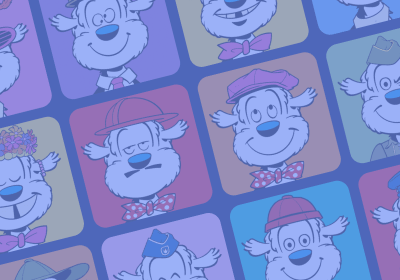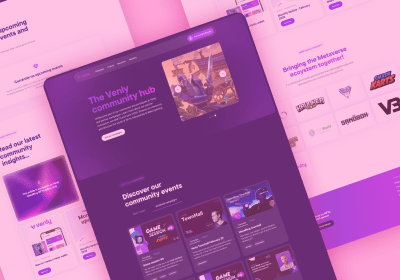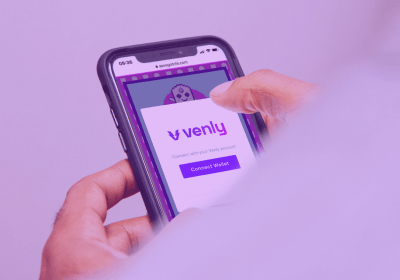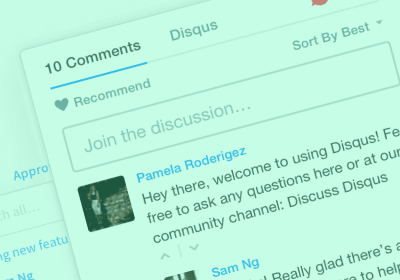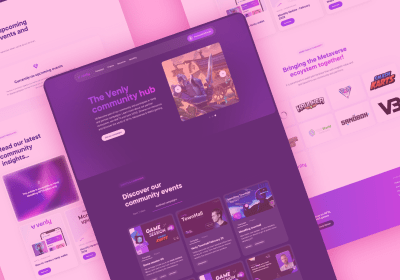
9 Stunning Web Design Trends Users Will Love In 2021

What are the hottest professional web design trends in 2021? To answer this question, we dive into the newest site design ideas. We'll review what's making the web more usable, functional, and all-around cool.

For web agencies and collaborative web design teams, it’s an exciting and challenging place to be. But with more function and appeal comes added complexity. Tech innovations like no-code, design systems, and atomic design power a new burst of web usability and sophistication.
To build the latest UI and UX web design ideas, here are our 9 top web design trends for 2021. It’s an inspirational list of future-forward web designs to build on. We’ll also review the best features making websites more stunning, useful, and sustainable.
From simple to complex, basic to advanced, here are our 2021 top web design trends, features, and ideas for bold new UX / UI designs - and why.
1. Minimalist, Modern Web Design Vibes
With people spending more time online, either working from home or the office, a website should look as pleasing as possible to the eyes. Simplicity and minimalism offer their own useful appeal, helping to simplify a brand’s design message. Some of the best “less is more” modern web layouts tend to use some of these minimalist styles:
- Soothing colors - Soft, smooth, pastel colors can help soothe tired user eyes. Muted tones are inviting and unobtrusive to look at.

- Focus effects - Subtle gradients like noise or gaussian blur can add a soft focus point, guiding the user gaze on a page. (Examples: Bold Monkey, DStudio)
- White space and negative space - Open, empty spaces help contrast next to impactful images or typography. (Examples: Exo Ape, Mihail Grinchuk)
- Color-less design - Black, white, and gray designs are making a comeback as clean, bold, print-inspired, and retro website styles. (Matt Wojtas, Magnet)
- Geometric grids - Blocks and lines are a simple way to structure content. They lend a clean, bold, and straightforward look to any web layout design. (Elegant Seagulls, Hudson Gavin Martin)
- Big, bold typography - Large, impactful fonts are a great way to display headline words or statements for bold impact. Simple backgrounds and custom typefaces add even more art to this effect. (Examples: Britton Stipetic, Maja Bjeletic)
- Cartoon illustrations - An artsy way to include unique stylized human figures. Cartoons can help add open, friendly and positive brand tone online. (Examples: Jarom Vogel)
- Neumorphism - Stylized realism mixes basic physical item attributes with semi-flat colors. Like digital embossing and debossing, it returns some depth to web designs. It doesn't use any realistic materials from past skeuomorphism designs. (Examples: George Tang, Agente)

Minimalist web design can better help communicate a brand's vision with users. It can convey a bold message with more clarity. Its clean lines offer a modern design style that is easy to work with.
2. Colors In 3D To Make Websites Pop
Web design color gradients have been trending for awhile now. This year will see them grow into brighter color transitions popping off screens. Inspired by Apple’s Big Sur OS, saturated 3D colors will keep blending with more imperfect, organic gradients. Designers will use these to add more interest and vibrant realism to web designs.

Rules for color blending and gradients have gone out the window. Designers are smearing bolder three-dimensional color backgrounds with less regard for boundaries. They're adding deeper shadow gradients to emphasize icons and elements. Pushing the boundaries of creativity, expect 3D color designs to go even further.
3. Abstract-Inspired Web Page Layouts
Designers are using abstract art compositions to express emotional freedom in web designs. Often these designs can replace stock photos or even cartoon designs. Layering bold colors with geometric shapes can help convey an evocative message in many different ways.

Abstract art ideas may be the easiest and most flexible to assemble, and will continue appearing in web design. Designers can make original visual statements with simple but creative element arrangements that are also highly reusable and efficient.
4. Retro-Futuristic Site Designs
The last decade of design has seen many retroactive or retro trends come back. The 1970's, 1980’s and 1990’s fashion, colors and fads have reappeared in the new millennium.

Building on this throwback resurgence, a retro-fonts and retro style movement also hit web design and continues in 2021. Vintage typography is mixing elements of old and new, adding new vitality into brand statements and headlines . Traditional fonts get a new makeover, with a bit of new styling and cool spin, while staying readable and impactful with users.
With the rebirth of past decades and older media, print-inspired websites have popped up too. Web layouts like print newspapers and magazines connect users with more familiar real objects. They bring back some of that special tactile experience of printed paper online.

Grainy textures can also create dramatic retro web designs. They can add a rugged and busy vibe to suit a brand image online.

5. Web Design Around Causes
If there’s something we all learned recently, it’s the power of the web to bring people together in times of need. Web designs will continue to help people in tough times with more purpose-driven web designs around issues and causes that can help.

Now more than ever, brands will focus web design on virtues and benefits like local initiatives and sustainability. Design elements will feature realistic photos of people, and accessible tools and information for all users.
Great web design and development will rally around worthy causes. Fostering deeper user connections with purpose will remain at the heart of meaningful web design ideals, this year and beyond.
6. Movement-Infused Websites
Animation and multimedia tech fuels user interest, interaction and connection online. Now, new layered themes help the user feel more immersed in the website design, forging a deeper connection with a brand’s message:
- Multimedia, audio and video - Combined visuals, text, video, and audio continue to make a rich user experience. Faster internet speeds open doors for more multimedia web applications. User-guided controls and broad accessibility should still be part of great multimedia web designs. (Example: Arne Van Kauter)
- Parallax effects - Parallax animation gives users an intriguing appearance of distant movement online. Still, background and foreground element animations should work subtly. They should draw users into a website, but avoid disorienting or distracting them from the brand message. (Examples: Outcrowd, Minh Pham)
- Horizontal and vertical scroll - Scrolling cards, whether horizontal or vertical, add a sharp and eye-catching movement effect to web designs. They lend an instant engagement that begs a user to look deeper at a brand’s website messaging. (Examples: Hrvoje Grubis, tubik via Dribbble)
7. Clever Web User Interactions
User-driven website interactions are great tools to build more lasting brand relationships online. They can help add valuable website engagement time, and create a lasting impression for greater marketing impact.
- Scrolling transformations - User scrolling may be the most subtle but powerful way to interact online. Strategic web movement under the user’s scroll button can delight more people. They'll engage with your brand story in new ways online. (Examples: pixelart, Outer Studio)
- Surveys and questionnaires - A great way to captivate user interest and action by capturing their preferences online. Whether it’s part of the site’s design options, or a short topic survey, it’s a deeper way to increase brand understanding and recall. It can be a faster way to onboard customers and tailor product features and messaging. (Examples: Arsen Kolyba, Sean Nelson)
- Scrollytelling - A new twist on user interaction and scrolling, it lets designers combine a story-telling narrative with the user’s own web scrolling power. It’s best limited to one area of the site, and should aim to keep the user in full control of the movement. Designers can use scrollytelling to illustrate a brand’s story without distracting from its major message or tone. (Examples: Zach Holman UTC, Snowfall NYT)
- Custom web cursors - While not the newest, original web design trend, it’s one that goes further with today’s web code technology. A custom cursor is a magic wand that boosts brand recognition and can add a user smile applied in a website’s message and style. It’s a feature geared for desktops, but can add smiles and brand recall power in the web user’s experience. (Examples: Volodymyr Kurbatov, Outer Studio, Burocratik)
- Tracked cursor movements - Another cool web animation feature that has come a long way. Developers now have a wide range of coding power and options to apply the coolest effects of tracked cursor movements on websites. They can use this to foster more user interaction, adding a fun -if not meaningful- tone to a brand’s message. (Examples: Impero,Burocratik)
8. Preference-Based Website Designs
Offering web users their choice in a website’s appearance or function will never go out of style. The internet’s evolution has hinged on a greater ability to personalize and become a more active, user-centered medium. (Example: Louis Vuitton Brasil)
Options like changing a site’s language, switching between light or dark color modes, or even choosing a custom navigation appearance online. Even offering custom-tailored content, like streaming audio music services allowing their users to tailor their own playlist suggestions.
This is a lasting trend that is propelling the web further forward. It’s empowering more design practices and algorithms to personalize web experiences for users' tastes, wants, requests, and needs - making more meaningful web surfing experiences.
9. Smarter Web Design Automation
Web developers are coding a smarter, better, faster internet for all today. With tech innovation and ingenuity, coders are making the web provide more enhanced user experiences. They’re building new web features to broaden its use, performance, and scale.
Basically, the web works for users more intuitively every day. This trend to automation is enabling people across the world to take new steps forward in their technology use. It’s democratizing computing power and web access in unseen ways we once only dreamed of.
Thanks to the newest no-code and low-code automation trends, new modes of web work and creation are empowered. Almost anyone can now build complex UX driven (user-experience) web designs using streamlined UI (user-interface) tools and modules. These tools and modules are already pre-built by skilled coders for exactly that purpose.
Teams can access detailed, shared projects efficiently online. They can collaborate inside cloud-based web design UI portals. Smart A.I. data algorithms inside modular systems can enhance user choices, speed and performance by doing some of the thinking for them. Users have more coded, creative, and automated web systems now than ever. It’s Web 4.0 all the way!
This new, accessible web computing power and design helps the internet achieve larger goals. The web is now a truly shared tool, connecting people and purpose in more inclusive, authentic, transparent, and ethical ways.
Top UX UI Web Design Trends Beyond 2021
People spend a lot of time on the web, so clever agencies should think about web designs that continually elevate user experiences more.
Awesome design with smooth features will drive even more user interest, expanding the web's boundaries further. Daring brands and agencies can continue to adopt the most user-centric UX and UI trends, to make bigger impressions in 2021 and beyond.
Can you spot the latest web trends we use the most in our own SiteManager design? How do you see future web design evolving next? Continue the conversation with us here, or on social media. We look forward to your thoughts!
Start building today
Streamline your creative process and keep your team aligned with our collaboration tool.
